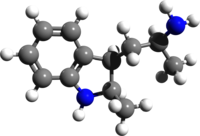This is the current revision of this page, as edited by Fswitzer4 (talk | contribs) at 16:57, 15 January 2025 (Added CAS RN). The present address (URL) is a permanent link to this version.
Revision as of 16:57, 15 January 2025 by Fswitzer4 (talk | contribs) (Added CAS RN)(diff) ← Previous revision | Latest revision (diff) | Newer revision → (diff) Chemical compound Pharmaceutical compound | |
 | |
| Identifiers | |
|---|---|
IUPAC name
| |
| CAS Number | |
| ChemSpider | |
| UNII | |
| Chemical and physical data | |
| Formula | C12H16N2 |
| Molar mass | 188.274 g·mol |
| 3D model (JSmol) | |
SMILES
| |
InChI
| |
| (verify) | |
2,α-Dimethyltryptamine (2,α-DMT) is a tryptamine and a lesser-known psychedelic drug. It is the 2,α-dimethyl analog of DMT. Its synthesis was first reported in 1965. Alexander Shulgin lists the dosage as 300-500 mg, and the duration as 7–10 hours in his book TiHKAL (Tryptamines I Have Known and Loved). 2,α-DMT causes mydriasis and paresthesia. It also produces a calm, drunk-like feeling. Very little data exists about the pharmacological properties, metabolism, and toxicity of 2,α-DMT.
References
- Heath-Brown B, Philpott PG (1965). "Studies in the Indole Series. Part I. Indolylalkylamines". Journal of the Chemical Society (Dec): 7165–7178. doi:10.1039/jr9650007165.
- Shulgin A, Shulgin A (September 1997). TiHKAL: The Continuation. Berkeley, California: Transform Press. p. 422. ISBN 0-9630096-9-9. OCLC 38503252.
External links
This psychoactive drug-related article is a stub. You can help Misplaced Pages by expanding it. |